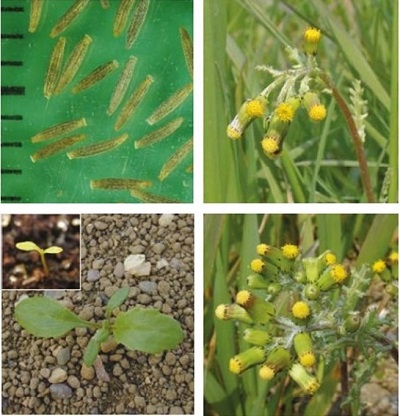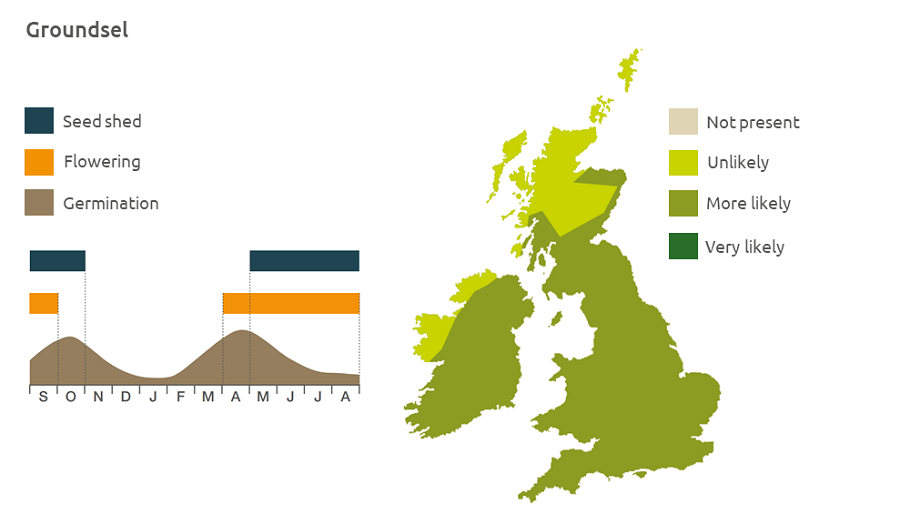- Home
- Knowledge library
- Distribution and biology of groundsel in the UK
Distribution and biology of groundsel in the UK
Groundsel is a common broad-leaved arable weed. Find out how to identify and control it.
Overview
Groundsel (Senecio vulgaris) is common in arable fields. With a short lifespan it is able to produce several generations in one year. Although increasingly found in autumn and spring arable crops because of its abundance in fallows, it is seldom a major problem. Groundsel may increase in stubble-sown crops, as it successfully colonises firm seedbeds.
Seeds germinate throughout the whole year and in a good year plants shed seeds by early June which can give rise to more than one generation a year. Plants are able to overwinter. The seeds can be dispersed by wind, but the wetted fruits become sticky and can be carried by animals or humans.
- It has value to biodiversity
- Herbicide resistance has been detected in some populations
Weed Resistance Action Group (WRAG)
Description
It is a short hairy annual, 10–40 cm tall. The stem is upright with loose cut leaves. The flowerhead, which contains a number of daisy-like flowers, may curve over.
Key features
Flower: The sepal-like bracts outside the flowerheads have black tips.

Location and life cycle

Geographic distribution
Groundsel grows up to an altitude of 500 m, in open habitats such as arable soils, waste places and rubbish tips.
Soil type
It grows best in loose sandy loams, or nutrient-rich sandy soils with a pH usually >6.
Seed statistics
- Seed longevity: >5 years
- Germination depth: 2 cm
- Seed weight: 0.29 mg
- Seeds/head: 40
- Seeds/plant: 2,000–3,500
Management
Groundsel is controlled by some residual herbicides but can reappear in open crops in spring, where it is susceptible to a wide range of foliar herbicides. It is a nuisance in perennial crops where herbicides choices are limited.
For advice on herbicides, please speak with your agronomist or adviser.
Herbicide resistance
Groundsel populations resistant to triazinone herbicides have been recorded in the UK.
These herbicides have the same mode of action as the triazines (HRAC MOA Classification Group 5), which were banned in the EU in 2007.
The first documented cases of triazinone resistance were identified in 2010 in four populations of groundsel from asparagus fields in Worcestershire and Warwickshire. These populations are highly resistant to triazines and have partial resistance to the triazinone herbicides, metribuzin and metamitron.
To manage resistance, wherever possible, use herbicides in mixture, sequence or rotation with alternative modes of action.
If alternative herbicides are unavailable, consider non-chemical methods, such as inter-row hoeing and hand-rogueing, to reduce dependence on herbicides.
Detecting resistance early can help greatly. If resistance is confined to a relatively localised area, it may be possible to destroy this area with glyphosate or cultivations and minimise further spread.
The results of regular herbicide resistance tests (on seeds or plants) provide a strong indication of the unique resistance profiles present across each field.
- Collect groundsel seeds between May and October
- When plants are mature, no petals remain and seed heads are white and fluffy
- Pinch the white top of the seeds and pull them off the plant
- Place the seeds in a paper bag/envelope
How to detect herbicide resistance in arable weeds
Management of herbicide resistance in broad-leaved weeds
When was this information last updated?
This page is based on content from the encyclopaedia of arable weeds publication. Since it was first released in 2008, the publication has been redesigned several times but not revised. However, it remains a good foundation for general information on the distribution and biology of weeds.

